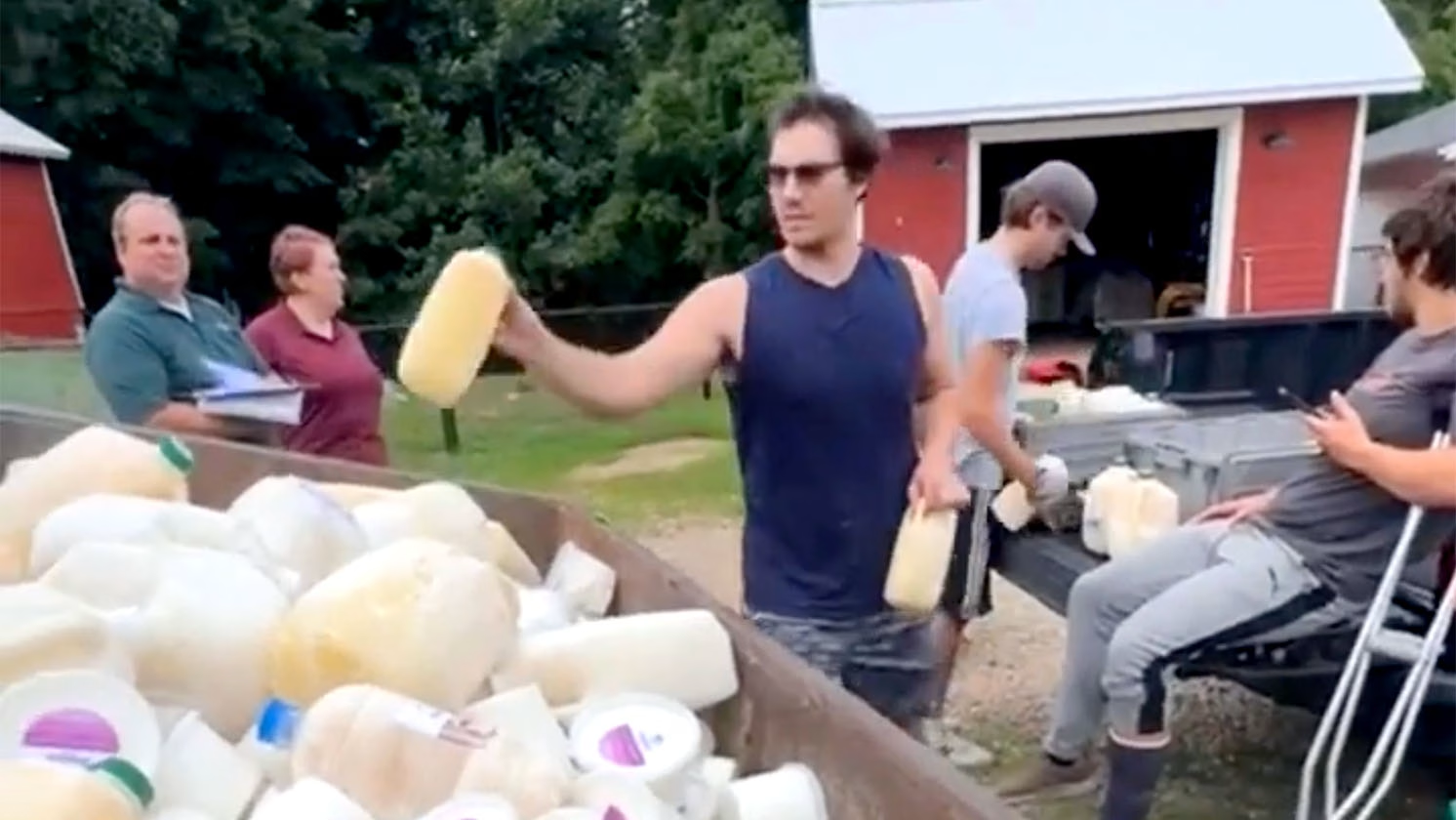Learn how beef-on-dairy is shaping beef production. Will it significantly impact the market? Find out in our expert analysis.
Summary: The beef-on-dairy trend is reshaping the dairy industry but making only a modest dent in U.S. beef production. In 2022, beef-on-dairy cattle comprised 7% of cattle slaughter, or 2.6 million head, with projections suggesting this could rise to 15% by 2026. However, this doesn’t increase the total cattle count but changes the composition, as more beef-on-dairy cattle replace traditional dairy-fed ones. While dairy farmers adopt beef semen to boost calf value, the overall beef production impact remains negligible. The adoption of beef-on-dairy has surged, reaching 7.9 million units in 2023 due to cost differences and breeding technology advances. Customer perception, market demand, and credibility from sources like branded beef programs will be critical to this trend’s longevity.
- Beef-on-dairy is growing, making up 7% of cattle slaughter in 2022, potentially rising to 15% by 2026.
- The trend doesn’t increase the total cattle count but changes the composition, replacing traditional dairy-fed cattle with beef-on-dairy cattle.
- Dairy farmers are adopting beef semen to enhance calf value, yet the overall impact on beef production is minimal.
- Adoption of beef-on-dairy reached 7.9 million units in 2023, driven by cost differences and breeding technology advances.
- Consumer perception, market demand, and credibility from branded beef programs will be crucial for the trend’s sustainability

Are you wondering about the latest buzz over beef-on-dairy? It’s no wonder that this movement is gaining traction. Dairy producers increasingly use beef semen in their herds to generate calves more suited for meat production. Understanding this trend is vital for dairy farmers and industry experts, as it directly affects calf value and beef output quality, potentially changing market dynamics. This crossbreeding approach uses existing dairy resources to increase profitability, has consequences for beef quality and production standards, and may impact market supply and demand for beef and dairy products. By delving into this concept, you’ll learn how it’s gaining traction, what it means for the overall beef production market, and why its impact may be less significant than some believe, giving you a better understanding of how this trend may shape the future of both the dairy and beef industries.
Why Beef-On-Dairy Is Gaining Ground: Key Figures and Future Projections
Beef-on-dairy adoption has expanded significantly, with Lauber et al. (2023) reporting that it climbed from 18% or 738 thousand head in 2019 to 26% or 1.12 million head by 2021. In 2023, the National Association of Animal Breeders reported that beef semen sales to the dairy sector reached 7.9 million units, accounting for 31% of overall semen sales to dairy farmers, which included sexed, conventional, and beef semen sales (NAAB, 2023).
Several variables are influencing this tendency. One advantage of utilizing beef semen in dairy cows is that the cost difference is minor. As a dairy farmer, you can look forward to the potential boost in calf value since crossbred cattle command higher market prices. Furthermore, advances in breeding technology and genetics make this an attractive alternative for many people, offering a promising future for the industry.
Experts expect beef on dairy will account for 15% of cow slaughter by 2026. Given the dairy industry’s ongoing acceptance, these estimates seem reasonable. So, what is the takeaway? Beef-on-dairy is here to stay and will undoubtedly expand. Still, its total influence on beef output will be minimal. Does this seem like a good opportunity for your farm?
The Historical Roots: Why Beef-On-Dairy Became the Go-To Strategy
Understanding beef-on-dairy’s origins helps explain why this technique has gained popularity in recent years. Historically, dairy farms concentrated entirely on milk production, which resulted in lower-value male calves from dairy breeds. These calves did not match the quality criteria of typical beef cattle, resulting in reduced market pricing. However, the successful introduction of beef-on-dairy in the mid-twentieth century changed this narrative, paving the way for its popularity.
The idea of beef-on-dairy has been introduced previously. Its origins may be traced back to the practical farming practices of the mid-twentieth century when farmers experimented with crossbreeding dairy cows with beef bulls to boost the marketability of their herd’s progeny. However, the introduction of modern reproductive technologies such as artificial insemination and sexed sperm in the late twentieth and early twenty-first century completely transformed this practice.
By the early 2000s, technology had improved enough to enable dairy producers to selectively breed their herds with beef traits, resulting in much higher calf quality. The result? More healthy beef-like calves grew quicker and sold for more incredible prices.
The tipping moment occurred in 2015. As market dynamics changed and dairy producers were under pressure from changing milk prices, many sought other cash sources. Beef-on-dairy methods offered a feasible alternative, providing higher financial returns without significantly modifying current operating structures. This shift was a response to the changing economic landscape of the dairy industry, where traditional revenue streams were no longer as reliable.
The approach gained traction as statistics revealed the economic advantages of raising a calf that might flourish in the meat market. This was not simply theoretical; real-world data, such as market prices for crossbred calves compared to purebred dairy calves, indicated significant increases in calf value owing to improved genetics from beef breeds.
Knowing this history helps us understand why beef-on-dairy has been a popular approach for many dairy companies. It is not enough to follow a trend; one must also make educated selections based on decades of development and technical breakthroughs. This understanding can give us confidence in the future of the industry and its ability to meet market demands.
The Evolution of Cattle: Breaking Down Beef-On-Dairy’s Impact on Production
Let’s look at how beef-on-dairy impacts total beef output. While the quantity of calves born to dairy cows stays constant, the types of cattle that enter the beef production system vary. We are considering a trade-off between conventional-fed dairy cattle and beef-on-dairy cattle.
Thus, beef-on-dairy gradually increases the number of animals entering the beef production chain. It alters the makeup of the cattle population. Instead of typical dairy breeds in the beef industry, you will see more beef-dairy crossbreeds.
What exactly does this imply for you? When conventional-fed dairy cattle are substituted with beef-on-dairy cattle, the kind of beef produced changes. Beef-on-dairy cattle exhibit features of both their dairy and beef parents, which may improve meat quality and output. This transition is mostly a reallocation of the beef supply chain, not an addition.
What was the result? While the total amount of beef produced may only increase somewhat, quality and market dynamics may change significantly. This adjustment mirrors a more significant industry trend, suggesting a continuing development in successfully balancing dairy and beef production to satisfy market demands. This trend indicates a shift towards a more integrated approach to cattle farming, where both dairy and beef production are considered in tandem to optimize market outcomes.
The Quality Over Quantity Paradigm: Exploring Beef-On-Dairy’s Market Impact
While beef-on-dairy does not increase the overall quantity of cattle, it does influence the kind of beef available on the market. With more beef genes in the mix, the meat quality may vary. Beef-on-dairy calves may have different live weights, dressing percentages, and carcass weights than conventional dairy cattle.
Let’s break it down. Traditional-fed dairy cattle weigh around 1,400 pounds, with an average dressed weight of 800 pounds. What happens when we go from beef to dairy? According to experts, beef semen may have a slightly lower live weight but a more significant dressing percentage. This implies that, although the original live weight is lower, the dressed weight may be more critical owing to increased meat output.
Assuming a moderate 3% increase in dressed weight for beef-on-dairy cattle, carcass weights might rise by around 24 pounds. If all non-replacement dairy calves were beef-on-dairy in 2023, it would result in around 3.84 billion pounds of beef, compared to 3.73 billion from standard-fed dairy cattle. This 0.42% increase may seem minor, but it is significant in an industry where every pound matters.
Another factor to examine is the percentage of beef-on-dairy calves that are steers, which often have higher dressed weights. Suppose a more significant proportion of beef-on-dairy calves are steers. In that case, beef quality and volume might be more influenced. The difference may not be substantial, but these tiny changes assist in refining the beef supply entering the market.
So, even if beef-on-dairy may not significantly increase total beef output, it does promise to enhance the quality and potential economic worth of the beef produced. This shift has potential for both the dairy and cattle industries.
Economic Considerations for Dairy Farmers: The Game-Changing Potential of Beef-On-Dairy
Let’s look at the economic implications for dairy producers. Could beef-on-dairy make dairy heifers more valuable than beef cattle? There is a solid argument for this. With cattle genetics, dairy calves may be transformed into higher-value beef animals. This move might result in increased cash flow from the same number of calves.
Consider this: if dairy farmers can earn more per head for beef-on-dairy calves, that would be a game changer. It might pay additional operating expenses or perhaps support agricultural upgrades. More money in farmers’ purses equals more profitability for dairy enterprises.
Now, how does this affect dairy herd expansion? Higher calf prices may make dairy production more profitable. If revenues grow, some dairy producers may decide to enlarge their herds. More cows may produce more milk and beef-on-dairy calves, resulting in a growth cycle and increased profitability.
So, although beef-on-dairy may have little influence on overall beef output, the ramifications for dairy producers’ bottom lines are significantly more severe. That is why it is critical to monitor this development attentively. It has great potential to shape the future of dairy operations.
Consumer Perception and Market Demand: What’s the Buzz on Beef-On-Dairy?
How do customers perceive beef-on-dairy products, and is there increasing market demand? This issue is crucial to determining the trend’s long-term durability. It’s a topic worth discussing, particularly for those involved in the dairy and meat sectors.
Interestingly, customer opinion is typically influenced by several elements, including quality, taste, ethical issues, and pricing. According to recent research, most customers are unfamiliar with the intricacies of beef-on-dairy products. Still, they are willing to test them provided they fulfill quality and flavor standards. Credibility from reliable sources, such as branded beef programs, might have a substantial impact on these impressions.
In terms of commercial demand, millennials and Generation Z are especially interested in food that is produced sustainably and ethically. These populations are likelier to embrace beef-on-dairy crossbreeds because of their perceived efficiency and low environmental effects. This tendency is consistent with the increased demand for higher-quality beef without a substantial environmental cost.
Furthermore, the change to premium and branded beef programs would increase customer trust. Programs that guarantee beef-on-dairy products’ quality and ethical standards might help increase market acceptability and demand. By emphasizing quality over quantity, you may establish beef-on-dairy products as a premium option.
However, market expansion will not occur suddenly. A concentrated marketing and educational campaign will be required to increase consumer awareness. If successful, beef-on-dairy might become a regular in grocery store meat departments and on high-end restaurant menus.
Consumer opinions are cautiously optimistic, and there is growing market demand, especially among younger, ecologically concerned customers. For dairy producers, this implies that beef-on-dairy might be the game changer in balancing profitability and sustainability.
Marketing and Branding: Will Beef-On-Dairy Raise the Bar or Rock the Boat?
Regarding marketing and branding, the emergence of beef on dairy has the potential to change things. Imagine a future in which your beef products meet or surpass quality requirements. Beef-on-dairy calves often inherit the marbling of their beef sires, which may lead to better ratings such as USDA Choice or Prime. This immediately contributes to branded beef campaigns that depend on superior quality. Consider Certified Angus Beef and other specialist marks that attract high rates. With beef-on-dairy, these programs may see an increase in eligible cattle, broadening the product offering.
However, the issue remains: will these quality premiums stay stable or endure volatility? Because beef-on-dairy strives to combine the most significant aspects of both worlds—beef and dairy—most signals point to sustained pricing. Consumers are continuously prepared to pay for quality. As long as beef-on-dairy production meets high standards, premiums should remain stable. The versatility of branded programs may also help to mitigate any transitory implications. As long as these programs can include beef-on-dairy cattle without violating their demanding standards, the marketing of U.S. beef products is expected to improve rather than deteriorate.
The Bottom Line
In terms of marketing and branding, the emergence of beef on dairy has the potential to change things. Imagine a future in which your beef products meet or surpass quality requirements. Beef-on-dairy calves often inherit the marbling of their beef sires, which may lead to better ratings such as USDA Choice or Prime. This immediately contributes to branded beef campaigns that depend on superior quality. Consider Certified Angus Beef and other specialist marks that attract high rates. With beef-on-dairy, these programs may see an increase in eligible cattle, broadening the product offering.
However, the issue remains: will these quality premiums stay stable or experience volatility? Because beef-on-dairy strives to combine the most significant aspects of both worlds—beef and dairy—most signals point to sustained pricing. Consumers are continuously prepared to pay for quality. As long as beef-on-dairy production meets high standards, premiums should remain stable. The versatility of branded programs may also help to mitigate any transitory implications. As long as these programs can include beef-on-dairy cattle without violating their demanding standards, the marketing of U.S. beef products is expected to improve rather than deteriorate.
 Download “The Ultimate Dairy Breeders Guide to Beef on Dairy Integration” Now!
Download “The Ultimate Dairy Breeders Guide to Beef on Dairy Integration” Now!
Are you eager to discover the benefits of integrating beef genetics into your dairy herd? “The Ultimate Dairy Breeders Guide to Beef on Dairy Integration” is your key to enhancing productivity and profitability. This guide is explicitly designed for progressive dairy breeders, from choosing the best beef breeds for dairy integration to advanced genetic selection tips. Get practical management practices to elevate your breeding program. Understand the use of proven beef sires, from selection to offspring performance. Gain actionable insights through expert advice and real-world case studies. Learn about marketing, financial planning, and market assessment to maximize profitability. Dive into the world of beef-on-dairy integration. Leverage the latest genetic tools and technologies to enhance your livestock quality. By the end of this guide, you’ll make informed decisions, boost farm efficiency, and effectively diversify your business. Embark on this journey with us and unlock the full potential of your dairy herd with beef-on-dairy integration. Get Started!

















